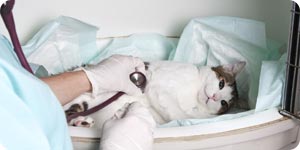
Feline Leukemia Virus (FeLV) causes feline leukemia, a type of cat cancer, as well as many other disorders including lymphoma, immune system suppression, anemia, gastrointestinal disorders, paralysis, and upper respiratory infections. In the first stage of FeLV infection, the virus is found in the blood but has not spread. Some infected cats can fight off the virus in this stage and have immunity thereafter. In the second stage, the virus spreads beyond the blood to invade the lymph nodes, bone marrow, and other parts of the body. Once this happens, some cats will have an active infection and begin to show more symptoms right away, while others will have a dormant infection that may show up later, after months or years.
- Transmission – Cats can get FeLV from an infected cat’s saliva, blood, urine, or tears. The most common modes of transmission are through mutual grooming, shared water and food dishes, bites, and blood transfusions. Kittens may also be infected by their mothers before birth or while nursing.
- Symptoms – The first stage symptoms, low fever, malaise, and swollen lymph nodes, are mild and usually missed by the pet owner. Once the virus has spread beyond the blood, symptoms include loss of appetite, weight loss, anemia, sluggishness, diarrhea, and blood in the stool.
- Diagnosis – There are two blood tests used to make a diagnosis of FeLV. The ELISA (enzyme-linked immunosorbent assay) is performed in the veterinarian’s office and detects the virus in the first or second stage of infection. The ELISA can give false positives and therefore, a second test is run to confirm a diagnosis. The IFA (immunofluorescence assay) is sent to an outside lab and detects the second stage of infection only.
- Treatments – There is no cure for the feline leukemia virus and treatments vary depending on what stage of infection the cat is in as well as what secondary disorders he has. For the FeLV positive cat that has no symptoms, there is just careful monitoring of his condition. Continue to maintain good health with good nutrition and a stress-free environment. Eliminate your cat’s contact with other cats to reduce chances of secondary infections and to prevent your cat from spreading the FeLV to others. Other treatments include:
- Prednisone and chemotherapy – used to induce remission in cancer caused by FeLV
- Antibiotics – to fight secondary infections
- Pain relievers – to reduce the pain that can accompany many secondary diseases
- Staphylococcal protein A, immunoregulin, interferon, propionibacterium acnes, BCG, acemannan, and nutritional supplements – Scientific studies are conflicted on whether these treatments are consistently successful, so talk to your veterinarian to decide if they are appropriate for your cat.
- Staphylococcal protein A – may reverse infection of the virus, induce remission of lymphoma, and treat anemia associated with FeLV
- Immunoregulin, acemannan, propionibacterium acnes, and BCG – may stimulate immune system
- Interferon – may increase survival time
- Prevention – Vaccines, although not 100% effective, can be given to cats that have not been exposed to FeLV, and are highly recommended for cats from multi-cat households and outdoor cats. It is best to keep your cat indoors at all times and away from FeLV infected cats. If you have a multi-cat household and one cat has FeLV, then quarantine the infected cat to prevent transmission of the virus to the others. Clean the infected cat’s dishes, litter box, etc. with a household disinfectant frequently.
Cats infected with the feline leukemia virus can live months to years after contracting the virus. Work together with your veterinarian to provide excellent cat health care and make that time as comfortable as possible for your cat.
